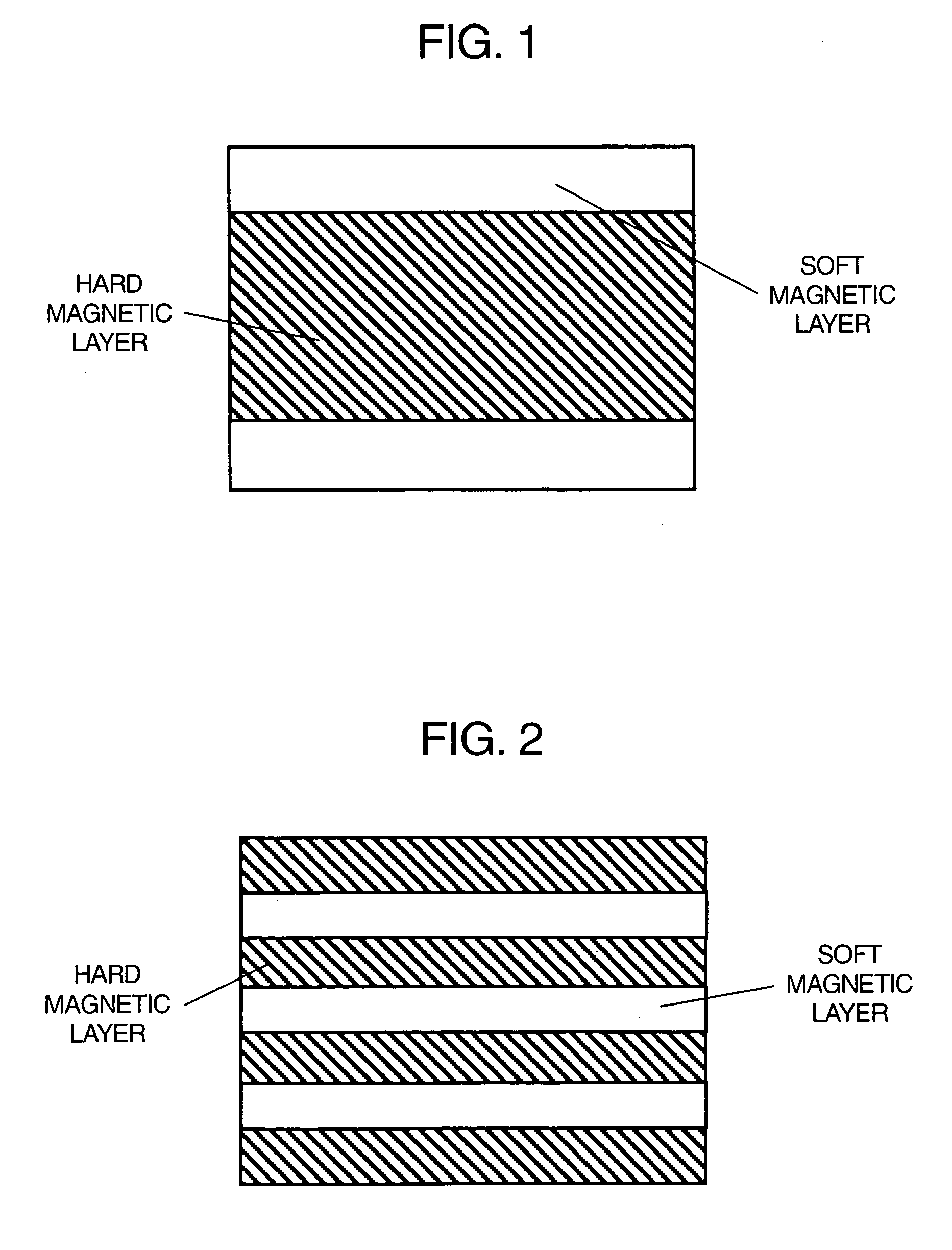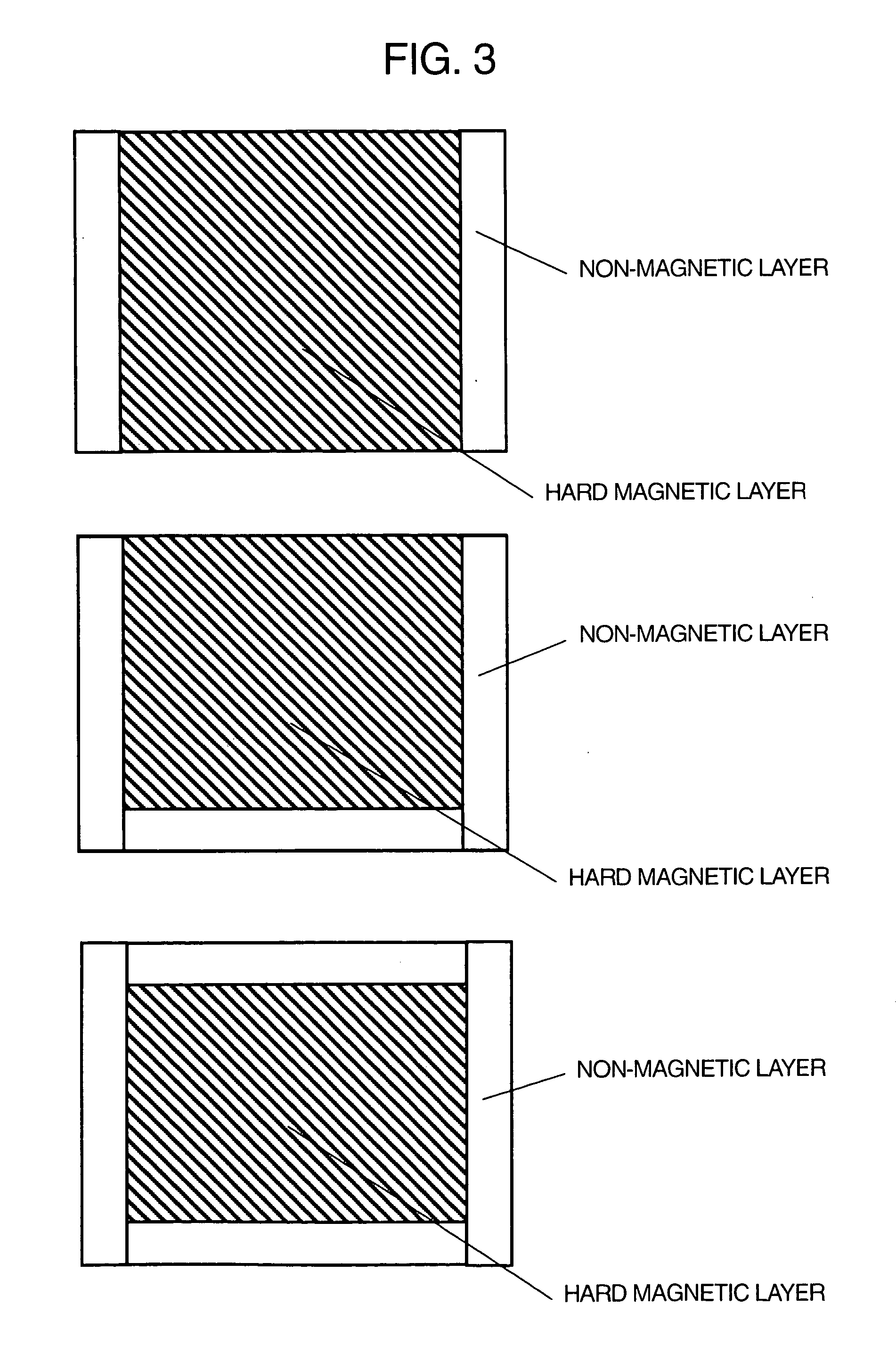Solid material for magnet
a solid material and magnet technology, applied in the direction of magnetic materials, magnetic bodies, inductance/transformer/magnet manufacturing, etc., can solve the problems of difficult to solidify the same through self-sintering, the type of bonded magnet cannot be employed, and the difficulty of industrially applying such a compacting pressur
- Summary
- Abstract
- Description
- Claims
- Application Information
AI Technical Summary
Benefits of technology
Problems solved by technology
Method used
Image
Examples
example 2
[0227] Powders of Sm and Fe metals in a predetermined amount (at a weight ratio of 16.85:83.15) were subjected to a mechanically-alloying treatment by means of a vibration ball-mill for a period of 180 ks, and thereafter heat-treated at a temperature of 600.degree. C. in vacuum for a period of 7.2 ks. These powders included about 30% by volume of a Fe soft-magnetic material. The powders were subjected to nitrogenation and hydrogenation at a temperature of 380.degree. C. in an ammonia-hydrogen mixed gas flow-current having an NH.sub.3-partial pressure of 0.35 atm and a H.sub.2-partial pressure of 0.65 atm for a period of 1.2 ks, and subsequently heat-treated at the same temperature in hydrogen for a period of 300 seconds. Using these powders, a solid material for a magnet having a composition of Sm.sub.6.1Fe.sub.81.6N.sub.9.2H.sub.3.1 was produced in a similar manner to the one in Example 1, except that the pressure of shock-waves was set to 18 GPa.
[0228] This solid material for a ma...
example 3
[0230] R--Fe--N--H system powders having an average particle size of 2 .mu.m which had been derived in Example 1, and Sm--Co system powders having an average particle size of 25 .mu.m and a composition of Sm.sub.11.5Co.sub.57.6Fe.sub.24.8Cu.sub.4.4Zr.sub.1.7 were charged into an agate mortar so that a volume ratio of 50:50 could be derived, and were wet-blended in cyclohexane.
[0231] Using these blended powders, an R--Fe--N--H system solid material for a magnet was prepared in a similar manner to the one in Example 1, except that the pressure of shock waves was set to 14 GPa. This solid material for a magnet was magnetized in a pulsed magnetic field of 4.0 MA / m, and the magnetic properties were determined. Resultantly, a residual magnetic flux density (B.sub.r)=1.10 T, a coercive force (H.sub.cJ)=0.83 MA / m, (BH).sub.max=209 kJ / m.sup.3 were derived.
example 4
[0232] According to a photolysis method using publicly known diethyl zinc, Sm--Fe--Co--N--H magnetic powders having an average particle size of about 1 .mu.m, the surfaces of which were coated with a Zn-metal were prepared. Using these powders, a solid material for a magnet having a composition of Sm.sub.8.4Fe.sub.64.3Co.sub.7.1N.sub.12.6H.sub.3.4Zn.sub.4-.2 was produced in a similar manner to the one in Example 1, except that the pressure of shock waves was set to 16 GPa.
[0233] This solid material for a magnet was magnetized in a pulsed magnetic field of 4.0 MA / m, and the magnetic properties were determined. Resultantly, a residual magnetic flux density (B.sub.r)=1.27 T, a coercive force (H.sub.cJ)=0.76 MA / m, (BH).sub.max=257 kJ / m.sup.3, and a density of 7.71 g / cm.sup.3 were derived. Furthermore, it was analyzed according to an X-ray diffraction method. Resultantly, it was confirmed that the solidified solid material for a magnet has a crystal structure of Th.sub.2Zn.sub.17-type rh...
PUM
| Property | Measurement | Unit |
|---|---|---|
| density | aaaaa | aaaaa |
| density | aaaaa | aaaaa |
| density | aaaaa | aaaaa |
Abstract
Description
Claims
Application Information
 Login to View More
Login to View More - R&D
- Intellectual Property
- Life Sciences
- Materials
- Tech Scout
- Unparalleled Data Quality
- Higher Quality Content
- 60% Fewer Hallucinations
Browse by: Latest US Patents, China's latest patents, Technical Efficacy Thesaurus, Application Domain, Technology Topic, Popular Technical Reports.
© 2025 PatSnap. All rights reserved.Legal|Privacy policy|Modern Slavery Act Transparency Statement|Sitemap|About US| Contact US: help@patsnap.com



